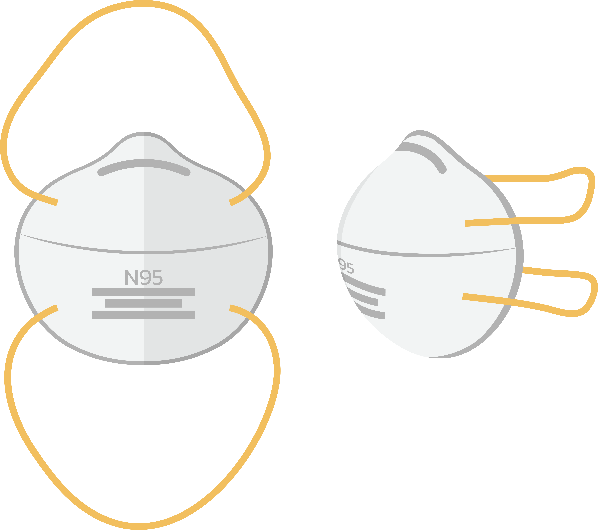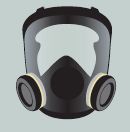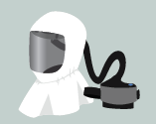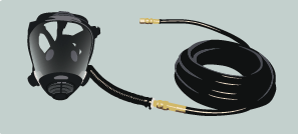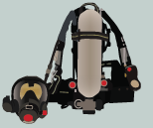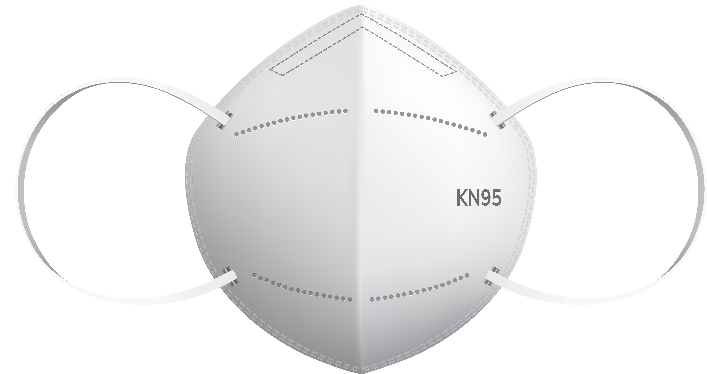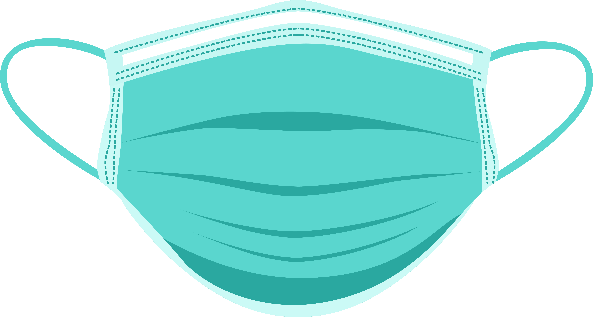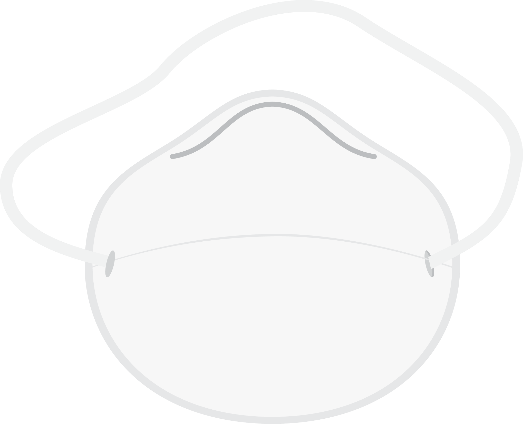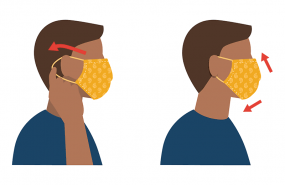Form Attachments 1-3 Attachments 1-3 Survey Protocol - SRUP Phase 2 Cognitive Testing
Cognitive and Psychological Research
Attachments 1- 3 Survey Protocol - Final
Cognitive Testing for the Survey of Respirator Use and Practices
OMB: 1220-0141
Attachment 1 - Protocol for the Phase 2 cognitive interviews
Introduction
If you are okay with it, we would like to have some observers also listen to our conversation. We have someone other colleague(s) from BLS who would like to hear your thoughts. This is strictly for note taking and observational purposes to help inform the design of the survey. You can feel free to decline having the additional observers if you prefer.
*If participant agrees, ask the observers to introduce themselves.
*Ask that observers please place their cameras off and place themselves on mute.
The National Institute for Occupational Safety and Health (NIOSH), which is part of the U.S. Centers for Disease Control and Prevention, is responsible for conducting research and making recommendations for the prevention of work-related injuries and illnesses. NIOSH is interested in learning more about the use of personal respiratory devices use in businesses across the U.S. and especially how the recent coronavirus pandemic has affected use in the workplace. In addition to learning where and how respirators are being used, this information will help improve use and training across the country.
Our purpose in talking with you today is to learn how businesses, such as yours, use personal respiratory devices. Before we conduct a survey, we want to make sure that we have identified the correct issues, are using terminology that everyone will understand, and that we ask the right set of questions.
Informed Consent
Before we begin, we have some consent information.
*Showcard on informed consent*.
The Bureau of Labor Statistics, its employees, agents, and partner statistical agencies, will use the information you provide for statistical purposes only and will hold the information in confidence to the full extent permitted by law. In accordance with the Confidential Information Protection and Statistical Efficiency Act (44 U.S.C. 3572) and other applicable Federal laws, your responses will not be disclosed in identifiable form without your informed consent. Per the Federal Cybersecurity Enhancement Act of 2015, Federal information systems are protected from malicious activities through cybersecurity screening of transmitted data.
|
Do you have any questions before we proceed?
Background for Cognitive Interview
I’d like to start by learning a little about your company. Can you give me a brief description of what your company does?
How many locations does your company have?
[IF MORE THAN ONE LOCATION] Do the other locations do the same types of activities or different activities than the location you reported about?
How many people are employed overall at your company?
What is your title/role in [COMPANY NAME]?
Instructions for Cognitive Interview
Thank you for that information. Next, I’m going to ask you to complete the survey, as I follow along and ask a few questions.
I am going to share my screen with you, which will be the survey. I will enter in your responses as we go through the survey. If a question isn’t clear or you don’t understand some wording that is used, please let me know. We want these questions to be clear and easy to understand.
Also, there may be questions where you are reluctant to provide a certain answer. If that happens, please let me know.
Also, please mention any questions where you would have to check records or ask someone else for the information
Survey
This survey is about the use of personal respiratory devices in businesses across the U.S.
We will be discussing NIOSH approved respirators (which we’ll refer to as “respirators”) and other personal respiratory or source control mitigation devices that are not NIOSH approved, which we’ll refer to as “masks.”
Respirators include
NIOSH-Approved Filtering Facepiece Respirators (FFRs) (e.g., N95, P100)
Elastomeric Half-Mask or Full Facepiece Air Purifying Respirators
Powered Air-Purifying Respirators (PAPRs)
Supplied Air Respirators
Self-Contained Breathing Apparatus (SCBAs)
Escape Respirators
Masks include:
Non-NIOSH Approved Emergency Use International Respirators (e.g., KN95)
Medical Procedure Mask (e.g., surgical mask, disposable face mask) Dust Masks
Cloth Masks or other Face Coverings
This voluntary survey is being conducted for informational purposes only, and the results will not be used in any type of enforcement activity. Please be assured that your responses will remain confidential and be used for statistical purposes only.
Who should complete this survey?
This survey should be completed by someone knowledgeable about the use of personal respiratory devices in your establishment. If necessary, please forward this survey invitation to that person or contact us (Phone: xxx-xxx-xxxx; email: [email protected]) to provide us with that person’s contact information.
What if we don’t use respirators or masks in this establishment?
Even if none of your workers use personal respiratory devices or masks, please complete the survey. You will only be asked a few questions, and your response will help us determine how the use of respirators is distributed among different industries and how the COVID-19 pandemic has influenced the use of respirators and masks.
Answer the questions for this location:
Please answer the survey questions only for the location shown below:
[Insert Establishment Name & Address]
If you have any questions, please do not hesitate to call (xxx-xxx-xxxx) or email ([email protected]).
Our Pledge of Confidentiality
The Bureau of Labor Statistics, its employees, agents, and partner statistical agencies, will use the information you provide for statistical purposes only and will hold the information in confidence to the full extent permitted by law. In accordance with the Confidential Information Protection and Statistical Efficiency Act (44 U.S.C. 3572) and other applicable Federal laws, your responses will not be disclosed in identifiable form without your informed consent. Per the Federal Cybersecurity Enhancement Act of 2015, Federal information systems are protected from malicious activities through the cybersecurity screening of transmitted data.
PROBES:
Who would typically be the person in your company who would answer questions about personal respiratory devices and other face coverings?
[If necessary, probe to find out if our instructions would accurately get to that person]
Administrative Questions
1. For this survey, we would like you to answer questions about the use of respiratory devices and masks at the location listed below. If you have other locations, only include information about this one address.
BUSINESS NAME
STREET ADDRESS
CITY, STATE ZIP
PROBES:
Are you able to provide information about the use of respirators and masks at this location?
If no, is there someone else who would be better able to answer the questions?
Do any employees at this location use respirators or masks?
If no, do you have employees at other locations that use respirators or masks? (If yes, use that location for the cognitive interviews)
2. How many people are currently employed at this location?
Include:
Full-time and Part-time employees
Employees who are contracted to work at other locations for other companies
Temporary and Seasonal employees
Do not include:
Contract or sub-contract employees
PROBE:
Are there any employees you aren’t sure whether to include in the count or not?
3. How many people were employed at this location as of January 1, 2020, prior to the COVID-19 pandemic?
Include:
Full-time and Part-time employees
Employees who are contracted to work at other locations for other companies
Temporary or Seasonal employees
Do not include:
Contract or sub-contract employees
4. Our records have the following NAICS code listed for your establishment: “XXXXXX.” Is this code correct?
Yes (skip to Q6)
No
Don’t know (skip to Q6)
5. Please enter your current NAICS code if you know it.
If you don’t know your NAICS code, please review the products or services listed below. Our records show that they are similar to your main products and/or services.
Have we correctly identified your main products or services?
Yes
No – please describe your main products and/or services
PROBES:
Did you have any difficulties with this section? If so, what were they?
[If necessary, probe on whether the NAICS code classification was correct}
Definitions
6. This is a survey to obtain information about the use of personal respiratory devices and other source control mitigation devices in U.S. businesses. Please review the list of devices below. For this survey, we will refer to the NIOSH-approved respirators (at the top of the list) as “respirators” and the other, non-NIOSH approved respiratory devices as “masks.”
Please review the list of respirators and masks below to see the differences between respirators and masks. In particular, note that N95 respirators are different from surgical masks, although they have often been used for the same purpose during the COVID-19 pandemic.
NIOSH Approved Respirators (referred to as “Respirators”) |
|
NIOSH-Approved Filtering Facepiece Respirators (FFRs) (e.g., N95, P100) |
|
Elastomeric Half-Mask or Full Facepiece Air Purifying Respirators |
|
Powered Air-Purifying Respirators (PAPRs) |
|
Supplied Air Respirators |
|
Self-Contained Breathing Apparatus (SCBAs) |
|
Escape Respirators |
Portable breathing apparatus or masks that regenerate breathable air to help provide respiratory protection for emergency escape from areas containing harmful gases or Immediately Dangerous to Life or Health (IDLH) atmospheres. Escape respirators come in a variety of shapes and forms. |
Other Personal Respiratory or Source Control Mitigation Devices (Non-NIOSH Approved Respirators and Masks/Coverings) (referred to as “Masks”) |
|
Non-NIOSH Approved Emergency Use International Respirators (e.g., KN95) |
|
Medical Procedure Mask (e.g., surgical mask, disposable face mask) |
|
Dust Masks |
|
Cloth Masks or Other Face Coverings (e.g., gaiters)
|
|
PROBES:
I’d like to get your feedback on the list of types of respirators and other source control devices. How comprehensive or not do you feel this list is?
[If necessary, probe for feedback on the provided images]
Were any of the categories of respirators or masks unfamiliar or surprising?
Are you familiar with the term “Source Control Mitigation Device”? What does it mean to you?
Respirator usage before and during the COVID-19 pandemic
Transition: The next few questions will ask about the use of respirators and masks before, during, and after the COVID-19 pandemic at the location listed at the beginning of the survey.
7. How many employees at this location used each of the following respirators and masks for the time frames listed below? If employees wore multiple types of devices, include them in the count for each kind they wore.
-
Number of Employees who used the device as of January 1, 2020, prior to the COVID-19 pandemic
Number of Employees who currently use the device
NIOSH Approved Respirators
NIOSH-Approved Filtering Facepiece Respirators (FFRs) (e.g., N95, P100)
Elastomeric Half-Mask or Full Facepiece Air Purifying Respirators
Powered Air-Purifying Respirators (PAPRs)
Supplied Air Respirators
Self-Contained Breathing Apparatus (SCBAs)
Escape Respirators
Other Personal Respiratory or Source Control Mitigation Devices (Non-NIOSH Approved Respirators and Masks/Face Coverings)
Non-NIOSH Approved Emergency Use International Respirators (e.g., KN95)
Medical Procedure Mask (e.g., surgical mask, disposable face mask)
Dust Masks
Cloth Masks or other face coverings (e.g., gaiters)
PROBES:
Would you have to consult any records to answer this question?
How easy or difficult is if for you to provide these numbers?
[If needed] How did you count employees who wore more than one kind of respirator or mask?
[If the respondent indicates they can only provide estimates] If this question included the instructions “estimations are acceptable,” would that make it easier for you to answer?
[If necessary] Briefly, how has the coronavirus pandemic impacted how your business uses respirators?
8. We would like to know about peak respirator usage during the pandemic, to better understand the demand for each type of respirator and prepare for future pandemics. For the time period of March 1, 2020 to March 1, 2021, what was the maximum number of employees that were using the devices below at any given time? This peak may have occurred at different times during that 12-month period for each device.
-
Maximum number of employees using the device
NIOSH Approved Respirators
NIOSH-Approved Filtering Facepiece Respirators (FFRs) (e.g., N95, P100)
Elastomeric Half-Mask or Full Facepiece Air Purifying Respirators
Powered Air-Purifying Respirators (PAPRs)
Supplied Air Respirators
Self-Contained Breathing Apparatus (SCBAs)
Escape Respirators
Other Personal Respiratory or Source Control Mitigation Devices (Non-NIOSH Approved Respirators and Masks/Coverings)
Non-NIOSH Approved Emergency Use International Respirators (e.g., KN95)
Medical Procedure Mask (e.g., surgical mask, disposable face mask)
Dust Masks
Cloth Masks or other face coverings (e.g., gaiters)
[If Q7 and Q8 are 0 for all devices then skip to Q33.]
PROBES:
In your own words, what is this question asking?
How did you determine the timeframe to use to determine your response for each device?
How easy or difficult is it for you to answer this question?
Would you have to consult any records to answer this question?
How has respirator usage changed during the pandemic?
How much of this change is work-related compared to protecting against the coronavirus?
9. For each of the devices below, indicate why the use changed during the COVID-19 pandemic, if at all. (Select all that apply)
|
No change in usage |
To protect against the corona-virus |
To provide more protection from other hazards |
Because of shortages |
To find a more cost-effective solution |
Because of a change in the number of employees |
Because of changes in the tasks employees were doing |
Other |
NIOSH Approved Respirators |
|
|
|
|
|
|
|
|
NIOSH-Approved Filtering Facepiece Respirators (FFRs) (e.g., N95, P100) |
|
|
|
|
|
|
|
|
Elastomeric Half-Mask or Full Facepiece Air Purifying Respirators |
|
|
|
|
|
|
|
|
Powered Air-Purifying Respirators (PAPRs) |
|
|
|
|
|
|
|
|
Supplied Air Respirators |
|
|
|
|
|
|
|
|
Self-Contained Breathing Apparatus (SCBAs) |
|
|
|
|
|
|
|
|
Escape Respirators |
|
|
|
|
|
|
|
|
Other Personal Respiratory or Source Control Mitigation Devices (Non-NIOSH Approved Masks/Coverings) |
|
|
|
|
|
|
|
|
Non-NIOSH Approved Emergency Use International Respirators (e.g., KN95) |
|
|
|
|
|
|
|
|
Medical Procedure Mask (e.g., surgical mask, disposable face mask) |
|
|
|
|
|
|
|
|
Dust Masks |
|
|
|
|
|
|
|
|
Cloth Masks or other face coverings (e.g., gaiters) |
|
|
|
|
|
|
|
|
PROBES:
How did you decide on your response to this question?
Are there any other reasons why respirator usage might have changed?
10. Did you experience a shortage of NIOSH-approved respirators at this location during the COVID-19 pandemic?
-
Yes
No
Don’t Know
NIOSH Approved Respirators
NIOSH-Approved Filtering Facepiece Respirators (FFRs) (e.g., N95, P100)
Elastomeric Half-Mask or Full Facepiece Air Purifying Respirators
Powered Air-Purifying Respirators (PAPRs)
Supplied Air Respirators
Self-Contained Breathing Apparatus (SCBAs)
Escape Respirators
PROBES:
[IF yes to any] Can you say more about the shortage?
[If applicable, probe on DK/NA response option if chosen]
Occupation questions
Transition: This section will address respirator usage by occupation.
11. Do you currently have any employees in the occupations below at this location? [This list will be populated with up to 14 occupations and their definitions based on the NAICS code for this location]
-
Occupation
Yes
No
Don’t know
Occupation 1 - definition
Occupation 2 – definition
Occupation 3 – definition
Occupation 4 – definition
Occupation 5 – definition
Occupation 6 – definition
Occupation 7 - definition
…
PROBES:
Looking at this question, do the occupations listed here match occupations that you have in your business? If not, what is different?
Were the definitions of the occupations helpful? Were there any that were unclear?
12. Do employees in these occupations at this location currently use respirators or masks?
-
Occupation
Yes, Both Respirators and Masks
Yes, Respirators Only
Yes, Masks Only
No
Don’t know
List only occupations marked “Yes” in the question above.
[If any occupations use respirators and masks, respirators only, or masks only, pick one randomly to use and skip to Q15.
PROBE:
Are you familiar with the usage of both respirators and masks for the occupations listed?
13. Are there any other occupations at this location that currently use respirators?
Yes
No
Don’t know
PROBE:
If yes, what are they?
14. Of the occupations that use respirators at this location, which one would you say has the highest usage? [Use this answer to prefill remaining occupation-related questions].
[If respondent doesn’t know what rate means, suggest they use “number of hours of respirator usage.”]
PROBES:
Talk me through how you decided on this occupation.
[If applicable] How easy or difficult was it for you to identify the occupation in your company with the highest rate of respiratory use?
How did you interpret “highest rate” of respirator use?
Transition: The next few questions will ask about potential hazards and respirator usage for the occupation <fill occupation>. Please provide responses for just that occupation.
15. How many employees currently work in the occupation “<fill occupation>” at this location?
PROBE:
How easy or difficult is it to provide this number?
16. For employees in the selected occupation <fill> at this location, which of the substances listed below have been potential airborne hazards in their work environment in the last 12 months? Include hazardous substances that may be present above the OSHA Permissible Exposure Limits (PEL) or American Conference of Governmental Industrial Hygienists (ACGIH ) Threshold Limit Values (TLV) even if they are controlled through mechanical ventilation or some other viable control mechanism. (Select all that apply)
Gas or Vapor
|
Particulate
|
Both Gas/Vapor and Particulate
Other
|
PROBES:
Do the categories of Gas/Vapor, Particulate, Both, and Other make sense to you? Is it helpful to see the harmful substances categorized this way?
I’d like to get your feedback on the provided list of possible harmful substances. How comprehensive or not do you feel this list is?
Are you familiar with the terms “PEL” and “TLV”? What do they mean to you?
Did you consider including any hazards that are present below industry thresholds? How did you decide whether to include it or not?
[If applicable] – probe on how they decided on which other airborne hazard to write-in
17. Which types of respirators or masks are currently used for the occupation <fill occupation> at the location selected? (Select all that apply)
|
Used to protect against work-related hazards |
Used to protect against coronavirus |
Not used |
Don’t know |
NIOSH Approved Respirators |
|
|
|
|
NIOSH-Approved Filtering Facepiece Respirators (FFRs) (e.g., N95, P100) |
|
|
|
|
Elastomeric Half-Mask or Full Facepiece Air Purifying Respirators |
|
|
|
|
Powered Air-Purifying Respirators (PAPRs) |
|
|
|
|
Supplied Air Respirators |
|
|
|
|
Self-Contained Breathing Apparatus (SCBAs) |
|
|
|
|
Escape Respirators |
|
|
|
|
Other Personal Respiratory or Source Control Mitigation Devices (Non-NIOSH Approved Respirators and Masks/Coverings) |
|
|
|
|
Non-NIOSH Approved Emergency Use International Respirators (e.g., KN95) |
|
|
|
|
Medical Procedure Mask (e.g., surgical mask, disposable face mask) s |
|
|
|
|
Dust Masks |
|
|
|
|
Cloth Masks or other Face Coverings |
|
|
|
|
PROBES:
In your own words, in the context of this question what does “used to protect against work-related hazards” mean? What does “used for protection against coronavirus” mean?
[If necessary, what do you see as the main difference between the first two categories?]
How easy or difficult is this question to answer?
Are you able to track usage for the non-NIOSH approved masks?
18. How do employees in the occupation <fill> currently use respirators and masks to protect against work-related hazards? (Select all that apply)
Voluntary Use: Employee decides to use respirator (with the employer’s approval) for personal reasons (e.g., allergy, desire to reduce exposure beyond that required by regulation, etc.).
Required Non-Emergency Use: Respirator use for exposure to known substances which is required by regulation or by the employer.
Required Emergency Use: Respirator use as a result of an unplanned situation, including escape from or entry into a potentially hazardous environment.
-
Voluntary Use
Required Non-Emergency Use
Required Emergency Use
Don’t know
List of respirators and masks used for work-related hazards in Q17
PROBES:
Do these response options (column headers) make sense to you? Are you able to distinguish between the different situations?
Do you have any feedback on the explanatory text we have provided on the response options (e.g. voluntary use, required non-emergency use, and required emergency use)?
19. In the last 12 months, what percentage of their time do employees in occupation <FILL> wear respirators to protect against hazards associated with their work?
Use the chart below to help select an appropriate response.
|
Rarely |
Occasionally |
Sometimes |
Often |
Percent of Time |
Up to 2% |
2% up to 33% |
33% up to 67% |
67% or more |
Daily* |
Less
than |
10
minutes up to |
2
½ hours up to |
5 ½ hours or more |
Weekly* |
Less
than |
45
minutes up to |
13
hours up to |
3 ½ days or more |
Annually* |
Less
than |
1
week up to |
4
months up to |
8 months or more |
* Times are approximate and have been rounded based on 8 hours daily, 40 hours weekly, 2080 hours annually work schedule.
|
Rarely |
Occasionally |
Sometimes |
Often |
Usage Varies |
Don’t Know |
|
Up to 2% of their time |
2% up to 33% of their time |
33% up to 67% of their time |
67% or more of their time |
|
|
List of respirators used for work-related hazards in Q17 |
|
|
|
|
|
|
PROBES:
How did you determine your response to this question?
[If participant selected a percentage] How did you decide on the percentage?
[If participant selected “varies”] How does the usage vary? What does it depend on?
[If needed] Does it depend on anything other than their assignment/job task(s) on any given day?
Did you consider the values in the table for your response? Was the table helpful?
Were the category labels helpful? Were they meaningful? Were the percentages helpful? What about the range of times?
How easy or difficult was it for you to answer this question?
If the company uses masks only, but no respirators, then skip to end.
Filtering Cartridges and Canisters
20. If employees in occupation <FILL> at this location use gas and vapor filtering respirators, what color-coded labeling is used on the cartridges or canisters? Please select the primary gas/vapor chemical protections that are used. (Select all that apply)
We do not use gas and vapor filtering respirators
Magenta (High Efficiency Filter, P100 Filter) (Select only if this is the primary protection, not if it is used in combination with others)
Black (Organic Vapors)
White (Acid Gases like Chlorine, Hydrogen Chloride, and Hydrogen Sulfide)
Olive (Multi-Gas/Vapor Cartridge, CBRN canister))
Orange (Mercury Vapors)
Yellow (Organic Vapors/Acid Gas)
Green (Basic Gases like Ammonia and Methyl Amine)
Brown (Organic Vapors, Ammonia, and Acid Gases)
Blue (Carbon Monoxide)
Other, please specify:
Don’t know
PROBES:
How easy or difficult is it to answer this question?
What does the text: “Please select the primary gas/vapor chemical protections that are used” mean to you?
[If applicable], probe on how they decided on the “Other” write-in
Transition: The next sections will address questions regarding your respirator program for ALL employees at this location.
Note: If there is no respirator usage (whether or not there is mask usage) at this location based on the current usage, skip to Q33.
Fit Testing
21. Are employees who wear respirators at this location fit tested prior to using respirators?
Yes (continue to next question)
No (skip to Q24)
Don’t know (skip to Q24)
22. Which of the following methods do you currently use to assess your employees’ medical fitness to wear respirators at this location?
No medical fitness assessment
Questionnaire only
Questionnaire with follow up exam required
Questionnaire with follow-up exam as needed
Physical exam only
Other—please list:
Don’t know
PROBES:
[If applicable], probe on how they decided ‘DK’
[If applicable], what is the “Other” method that is used to assess employees’ medical fitness?
23. Who currently conducts the fit testing of the respirators at this location? (Select all that apply)
In-house staff
Employees fit test themselves
Respirator manufacturer’s sales/technical representative
Other outside party who provides a respirator fit testing service
Other—please list:
Don’t know
PROBES:
[If applicable], probe on how they decided ‘DK’
[If applicable], what is the “Other” who conducts the fit testing of respirators?
24. How helpful would it be to get more guidance and resources on the topics below related to the fit testing of respiratory protection in the workplace?
-
Procedures
No additional guidance needed
Somewhat Helpful
Moderately Helpful
Very Helpful
Not applicable
Don’t know
Medical evaluations and assessments
Selecting the appropriate size respirators for employees
Assessing comfort
Assessing adequacy of respirator fit
Conducting user seal checks
Other fit testing topics
PROBES:
How did you decide on your responses?
Did the scale make sense to you?
[If yes to “other”] What topics would you like to see more guidance on?
Are there other specific topics related to fit testing you would like to see on this list?
Training
25. Is respirator training currently provided to your employees who wear respirators at this location?
Yes,
No (skip to Q29)
Don’t know (skip to Q29)
PROBES:
[If applicable] probe on any hesitation/worries about selecting ‘No’ for this question
[If applicable], probe on how they decided ‘DK’
26. When is respirator training currently provided to employees who wear respirators at this location? (Select all that apply)
When the employee starts at the company
Annually
Other frequency (please specify):
Don’t know
PROBES:
[If applicable], what is the “Other” frequency?
27. How is respirator training currently provided to employees at this location? (Select all that apply)
Classroom training (real time, in-person or remote)
One-on-one training (real time, in-person or remote)
Online training (pre-recorded videos and materials)
Other, please specify:
Don’t know
PROBES:
In your own words, what does “classroom training” means to you? Can you provide any examples?
In your own words, what does “one-on-one training” means to you? Can you provide any examples?
In your own words what does “real time, in-person or remote” mean to you? Can you provide any examples?
[If applicable] What is the “Other method” for providing training?
28. Who currently provides the respirator training at this location? (Select all that apply)
The respirator program manager or other health and safety expert
A supervisor
Medical personnel
An external consultant or third-party company
A respirator manufacturer sales/technical representative
A designated employee other than those listed above
Other—please list:
No special training is needed
PROBES:
I’d like to get your feedback on the list of who conducts respirator training, how comprehensive is this list. Are there any other responses that should be included?
[If applicable], probe on how they decided ‘No special training is needed’
[If applicable], what is the “Other” who provides respirator training
29. How helpful would it be to get more guidance and resources on the training topics below?
Training Topic |
No additional guidance needed |
Somewhat Helpful |
Moderately Helpful |
Very Helpful |
Not applicable |
Don’t know |
Why the respirator is necessary |
|
|
|
|
|
|
Respiratory hazards |
|
|
|
|
|
|
Proper use of the respirator (including putting on and removing) |
|
|
|
|
|
|
Proper fit of the respirator |
|
|
|
|
|
|
How to check the seals of the respirator |
|
|
|
|
|
|
How to inspect the respirator |
|
|
|
|
|
|
Proper maintenance and storage of the respirator |
|
|
|
|
|
|
Capabilities and limitations of the respirator |
|
|
|
|
|
|
How to use the respirator in emergency situations |
|
|
|
|
|
|
How to recognize medical signs and symptoms that may limit or prevent the effective use of respirators |
|
|
|
|
|
|
Other training topics |
|
|
|
|
|
|
PROBES:
How did you decide on your responses?
[If yes to “other”] What topics would you like to see more guidance on?
How comprehensive is this list? Are there any other topics that should be included?
Respirator Maintenance and Replacement
30. How helpful would it be to get more guidance and resources on the topics below regarding the requirements associated with the procedures for managing personal respiratory protection in the workplace?
Procedure |
No additional guidance needed |
Somewhat Helpful |
Moderately Helpful |
Very Helpful |
Not applicable |
Don’t know |
Proper use of respirators during routine situations |
|
|
|
|
|
|
Proper use of respirators during emergency situations |
|
|
|
|
|
|
Cleaning and disinfecting respirators |
|
|
|
|
|
|
Storing respirators |
|
|
|
|
|
|
Inspecting respirators |
|
|
|
|
|
|
Repairing maintaining respirators |
|
|
|
|
|
|
Discarding and replacing respirators |
|
|
|
|
|
|
Selecting respirators to protect employees from potential hazards in their work environment |
|
|
|
|
|
|
Ensuring air quality and quantity for atmosphere supplying respirators |
|
|
|
|
|
|
Evaluating the respiratory protection program |
|
|
|
|
|
|
Ensuring that voluntary use of respirators is properly managed |
|
|
|
|
|
|
Other topics related to the requirements for managing a respirator program |
|
|
|
|
|
|
PROBES:
How did you decide on your responses?
[If yes to “other”] What topics would you like to see more guidance on?
Are there other topics related to managing a respiratory program that should be on the list?
31. What kinds of challenges do you face in carrying out your respiratory protection program?
32. We are interested in finding new ways to improve the design, effective use, and adoption of respirators. Regarding the respirator protection your organization currently uses, please share any suggestions or comments you have on the topics below:
Usability
Comfort and fit
Durability
Productivity
Communication and Awareness
Any other topics
PROBES:
Did the instructions make sense to you?
What do the topics listed mean to you? Are there any that could be combined? Are there any other topics you think people might provide comments on?
[If necessary] probe on any comments made.
DEBRIEFING/GENERAL
Thank you very much for that information. Now I’d like to ask a few broader follow-up questions to understand your answers and see how the questions worked for you.
[If they talked about dust masks] How did you define “Dust Masks”? How do they compare to “Cloth Masks”?
Were any of the questions sensitive in nature? Do you think businesses would be reluctant to answer any of them?
Do you have any suggestions on how we can make the questions better?
How easy or difficult would it be to answer these questions for another occupation that uses respirators?
How long would you estimate this survey would take you to fill out? Please make sure you are including time taken to consult other people and records if necessary.
For Multi’s:
Earlier you noted that your business had multiple locations? How easy or difficult would it be to provide these responses if a different location had been selected?
If more than one of your locations were selected for the survey, would you prefer to have all the surveys go to a central location or to the individual locations?
Attachment 2 – Email invitations for remote cognitive interviews
Subject: The U.S. Bureau of Labor Statistics requests your help
Hello,
The U.S. Bureau of Labor Statistics (BLS) and the National Institute for Occupational Safety and Health (NIOSH), which is part of the U.S. Centers for Disease Control and Prevention, are working together to conduct a survey about the use of respirators in businesses across the U.S. The survey will also evaluate how the COVID-19 pandemic affected the use of respirators in the workplace.
We want this survey to be as relevant and useful as possible. We are contacting you to give us feedback on this survey. Very briefly, our objectives in this discussion are to make sure that we are using terminology that everyone will understand, ask the right set of questions, and minimize how much time the questions will take. Your responses will be kept confidential.
We are looking for volunteers to speak with us about the use of personal respiratory devices in your establishment. Please respond to this email and we will schedule a time to talk. If you have preferred times, please let us know, and we’ll accommodate your schedule.
Because your participation is important, we may follow-up with a telephone call.
How long will this discussion take?
Depending on your comments and interest in the topics, we estimate that this will take about 45-60 minutes. However, you can end the conversation any time you desire.
Where will this discussion take place?
We plan to conduct this discussion remotely using Microsoft Teams.
We hope to hear from you.
Sincerely,
<Researcher Name>
Office of Survey Methods Research
Bureau of Labor Statistics
<Researcher Phone>
![]()
Attachment 3 - Informed consent for remote testing
Upon beginning a remote testing session, we will show the participants the following information and ask for their verbal consent prior to beginning the study:
We estimate the session will last a maximum of 60 minutes.
Your participation in this research project is voluntary, and you have the right to stop at any time.
The Bureau of Labor Statistics is conducting this voluntary study under OMB No. 1220-0141, which expires on May 31, 2021.2 Without this currently approved number, we could not conduct this research. If you have any comments regarding this estimate or any other aspect of this study, send them to [email protected].
Your responses are protected by law:
The Bureau of Labor Statistics, its employees, agents, and partner statistical agencies, will use the information you provide for statistical purposes only and will hold the information in confidence to the full extent permitted by law. In accordance with the Confidential Information Protection and Statistical Efficiency Act (44 U.S.C. 3572) and other applicable Federal laws, your responses will not be disclosed in identifiable form without your informed consent. Per the Federal Cybersecurity Enhancement Act of 2015, Federal information systems are protected from malicious activities through cybersecurity screening of transmitted data.
Do you agree to participate?
1 The DOL notes that information collection requirements submitted to the OMB for existing ICRs receive a month-to-month extension while they undergo review.
2 The DOL notes that information collection requirements submitted to the OMB for existing ICRs receive a month-to-month extension while they undergo review.
| File Type | application/vnd.openxmlformats-officedocument.wordprocessingml.document |
| Author | Kincaid, Nora - BLS |
| File Modified | 0000-00-00 |
| File Created | 2021-11-09 |
© 2026 OMB.report | Privacy Policy
